In the very beginning
- 11 February 2025
-
 Tony Moulin
Tony Moulin
- Reserves
YACWAG didn’t just drop from the sky ready-formed, it evolved from a line of community environmental endeavours.
Local Action for Nature in Yatton and Congresbury 1980s to 1999
Local action for nature in our two communities has been continuous for four decades. A group of parents from Yatton and Congresbury formed a nature group for young children in the early 1980s. This act had been inspired by Wildlife WATCH, the junior wing of the national partnership of County Wildlife Trusts. WATCH provided resources and training for leaders to deliver local programmes of activities and events for young people. The disused railway was an ideal venue for studying nature and practical nature conservation and linked Yatton and Congresbury. Leaders were trained from both communities and in time an amalgamated group formed – the Yeo Valley Wildlife WATCH Group. This was an umbrella covering different age groups from pre-school to teenagers. The WATCH Group proved very popular and at one time over 80 children from both parishes were signed up to a “branch” in each village.
In 1991 Yeo Valley Wildlife WATCH won a national Pond of the Year Award from the Wildfowl and Wetlands Trust for restoring the big pond adjacent to the disused railway and Biddle Street in Yatton. A pond dipping platform was installed and a hedge planted.
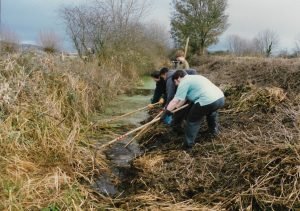
In the following years many of the same cohort of young people were able to give community service as part of their bronze and silver Duke of Edinburgh Awards by volunteering to clear scrub and clean out ditches. A Help a Toad Across the Road project which started in Yatton attracted a lot of attention and publicity engaging young and old alike along Mendip and Chescombe Roads.
Interest in nature conservation began to grow among the parents and other adults in the two parishes leading to the formation of the Yeo Valley Local Group of the Avon Wildlife Trust (AWT). This superseded the defunct Cadbury Hill Local AWT Group which had collapsed in the early 1990s. A key objective of a local group was to fundraise for the AWT and a dozen or so had been formed throughout the County of Avon at this time. The Yeo Valley Local AWT group had a natural affinity with the local WATCH Group and a number of key volunteers held positions of leadership in both.
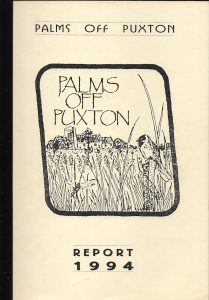
In 1994 members of these two groups were involved in organising a campaign to fight a development proposal for a holiday village on the proposed Puxton SSSI (designated later that year) and also two years later a proposal for landfill on the Biddle Street SSSI. Both campaigns, known as “Palms off Puxton” and “No Way Pilhay” respectively, were successful and AWT was subsequently able to purchase land on Puxton Moor SSSI to create a nature reserve.
During the 1990s the natural environment had crept up the political agenda, largely due to the Earth Summit held in Rio de Janeiro in 1991. A key principle was summed up in the slogan: Think Globally, Act Locally. Local Agenda 21 was born and nations around the globe started to set an agenda for the next century. Resources flowed more freely and volunteers in Yatton and Congresbury began to build a working relationship with officers of English Nature (now Natural England) who welcomed community involvement with Biddle Street SSSI (designated 1994).
The AWT and Woodspring District Council (now North Somerset Council) established the North Somerset Levels and Moors (NSLM) project in 1995 which reflected the growing recognition of the area. Avon Wildlife Trust had taken an interest in the Gordano Valley in the late 1980s and was extending its remit over the whole area that was becoming known as the “Forgotten Levels”. This was a reference to the Somerset Levels which received (and still does) the lion’s share of focus and funding at regional level. AWT received funding for a project officer, Tim McGrath, who regularly worked with landowners, farmers and the Yeo Valley WATCH Group on small projects including building an otter holt on Congresbury Moor and creating a wildlife map of Yatton and Congresbury. The Weston-super-Mare RSPB local group was also a major player in the project, carrying out bird surveys in the area covered by the wetland SSSIs. When the RSPB group folded some years ago YACWAG agreed to support Trevor Riddle so he could carry on co-ordinating the surveyors. He then started transects on Biddle Street SSSI and Kenn Moor SSSI.
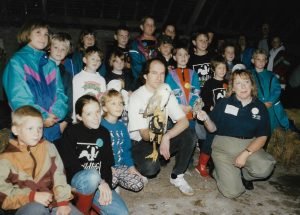
A partnership between the WATCH Group and the local Hawk and Owl Trust Group set up a two-year “Two Hoots” project in 1997 to raise awareness of the threats to two flagship owl species: Barn Owl and Little Owl. This project was a great success and contributed to raising awareness of our local wetlands. At that time Barn Owls had not been seen in the Yatton and Congresbury area for at least 25 years and probably a lot longer.
In response to Local Agenda 21 members of the Yeo Valley AWT Group began to rethink its focus. They decided to disband and establish a new local group, the Friends of Biddle Street SSSI (FoBSS) in 1996. This group became affiliated to the British Trust for Conservation Volunteers (BTCV, now TCV) and started regular conservation work for adults on the Biddle Street SSSI with a work party most weekends in the autumn and winter.
With the encouragement of English Nature and Woodspring District Council the new group entered into a three-year agreement (1996-99) under the Wildlife Enhancement Scheme (WES). WES was directly administered by English Nature until more recent times when administration of such grants was handed over to DEFRA and the Rural Payments Agency (RPA) and amalgamated with the Countryside Stewardship scheme. This change also heralded the gradual depletion of English Nature staffing and resources.
FoBSS received payments for reinstatement of the ditches on the Cheddar Valley Railway Walk between Yatton and Congresbury and maintenance through scrub clearance. This income funded tools and equipment and the regular party of volunteers became known as the “Action Team” and carried on for many years under the auspices of YACWAG. It also funded work carried out by contractors.
The Friends of Biddle Street SSSI’s outstanding achievement was assisting the acquisition of the Junction Reserve. This purchase was able to make the vitally important connection of the Cheddar Valley Railway Walk (now known as the Strawberry Line) with Yatton Station in 1998. Up until then the walk had ended in the middle of nowhere. FoBSS contributed to the land purchase fund and also obtained a grant from Yanley and North Somerset Environmental Company (YANSEC) to fence the land, a requirement of British Rail. YANSEC distributed a grant (derived from landfill tax rebates) for environmental and community projects. YANSEC went on to play an important role in the development of YACWAG’s aspirations to purchase land and survey equipment.
From the mid 1980s there was a continuity of organised activities and confidence in carrying out local action for the local environment. This group of people from Yatton and Congresbury had tasted success and were spurred on to explore further opportunities to benefit nature and to help formulate the local environmental agenda.
In 1999 a local farmer casually remarked that he was acquiring an auction lot of land on Congresbury Moor and that there was one field lot remaining but he was not interested in it. This was called Ten Acres, a large rectangular field created by the drainage and enclosure of Congresbury Moor in 1819.
A lot of energy was being spent on the council-owned disused railway but the purchase of Ten Acres would make a statement through providing land in the ownership of local people managed for the benefit of nature. The disused railway did after all have the Cheddar Valley Railway Walk Society as its guardian but what about Biddle Street SSSI?
The interesting feature was that one corner of the field virtually touched the Cheddar Valley Railway Walk (the name “Strawberry Line” had not been coined yet). It was separated by only an agricultural track and ditch. This factor was felt to be symbolic and the Friends were inspired to explore purchasing the field in order to extend their impact on the area for wildlife and to safeguard this field’s future through ownership.
Ten Acres was withdrawn from auction and the owner agreed that the field could be obtained through a private treaty sale and he would give the group a year to raise the £25,000 purchase price. However, it was realised that a charity would have to be formed to hold the land.
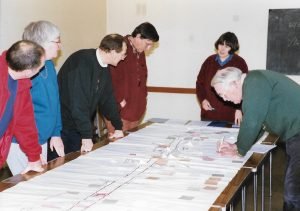
In January 1999 a group of twelve people were invited to discuss the project, agree a name for the new organisation and volunteer to become its founding trustees. In that initial discussion the word “action” was felt to be an essential part of the charity’s name to signify what the new organisation was all about. Funding for the project was to be pursued alongside satisfying the requirements of the Charity Commission. Finally the charity was approved and Yatton and Congresbury Wildlife Action Group was included in the register of charities on 2 July 1999.
In the first instance YANSEC was approached to find the sum of £25,000. They were interested but YACWAG was an unknown quantity and the charity was yet to be registered. However, it was agreed that 10 percent of the purchase price would be provided as match funding. An approach was made to the Heritage Lottery Fund (HLF) although some members felt that this would not be a suitable organisation to approach because HLF worked on a larger scale and the purchase of a single field was not on their agenda. However, surprisingly, they were interested and a HLF trustee, Palmer Newbould, arranged a visit to view the land with me and talk about the group’s achievements. Coincidentally the HLF was considering funding smaller organisations so our application was timely, resulting in an offer of a grant of £20,000. There was still a shortfall and another funder had to be found.

Fortuitously I attended a seminar on Wetlands at Bristol Zoo where David Bellamy, the natural history broadcaster, was the guest speaker. During a break in the proceedings I thought I would find out his thoughts on how we could find additional funding for a wetland field. He suggested that I contact his secretary at the Conservation Foundation and ask for a grant application form. A Gold Award of £2500 from Wessex Water soon followed to provide the gap in our funding and enable us to secure the HLF grant. The same group of funders came on board the following year to enable the charity to purchase New Croft and Meakers. YACWAG now owned three fields totalling 17 acres on the wetland SSSI and the breeding Kestrels, Barn Owls, Voles, Mice, Shrews, plants and insects were soon to follow.
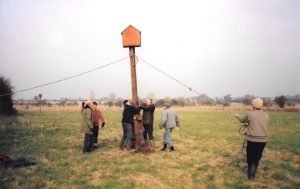
The two charitable objectives were devised by the late Michael Grant (treasurer from 1999 to 2007) and myself. The first was: “For the benefit of the public to establish and maintain nature reserves in Yatton and Congresbury”. The Charity Commission required the phrase “for the public benefit” to be added since our original objectives did not make it clear enough that our action would indeed benefit humankind. Nature and animals cannot directly be recipients of human charity! A second objective was also added to reinforce the public benefit requirement, namely: “To advance education in natural history and nature conservation”. This objective was not limited to the parishes and would enable the charity to broadcast and publicise its activities to a wider audience. It was also intended to be a catch-all statement to cover any activities that might be needed to support the main thrust – which was to create spaces for local nature to thrive and help people understand why we were doing this.
The rest, as they say, is history.
Tony Moulin. October 2024
© Copyright YACWAG, or original authors. All rights reserved. | Registered charity 1076362 | Privacy policy | Cookie policy | Terms & Conditions |Web design: StanfordGraphics


